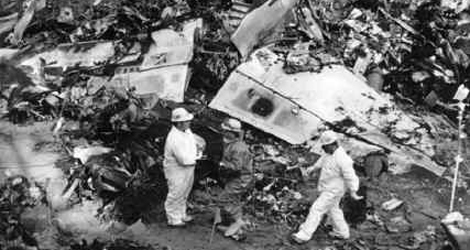On March 3, 1991, United Airlines flight UA585 was on a scheduled passenger flight from Denver, Colorado, to Colorado Springs, Colorado.
Visual meteorological conditions prevailed at the time, and the flight was on an instrument flight rules flight plan.

United Airlines flight UA585
Numerous witnesses reported that shortly after completing its turn onto the final approach course to runway 35 at Colorado Springs Municipal Airport, about 0944 mountain standard time, United Airlines flight UA585 rolled steadily to the right and pitched nose down until it reached a nearly vertical attitude before hitting the ground in an area known as Widefield Park.
United Airlines flight UA585 was destroyed, and the 2 flight crew members, 3 flight attendants, and 20 passengers aboard were fatally injured.
- The flightcrew was certificated and qualified for the flight.
- The airplane was properly certificated and maintained in accordance with existing regulations. Maintenance actions to correct the previous discrepancies related to uncommanded rudder inputs were proper and in accordance with maintenance manual procedures.
- The airplane was dispatched in accordance with company procedures and Federal regulations. Dispatch of the airplane with an inoperative APU generator was not a factor in the accident.
- There was no evidence that the performance of the flightcrew was affected by illness or incapacitation, fatigue or problems associated with personal or professional backgrounds. Procedures and callouts were made in accordance with UAL procedures.
- There were no air traffic control factors in the cause of the accident.
- There was no evidence of any preimpact failure or malfunction of the structure of the airplane or of the airplane’s electrical, instrument, or navigation systems.
- Both engines were operating and developing power at the time of impact.
- The crew did not report any malfunction or difficulties.
- Galling found on the input shaft and bearing from the standby rudder actuator power control unit could not cause sufficient rudder deflection to render the airplane uncontrollable.
- It is very unlikely that the loss of control in the United flight 585 accident was the result of an encounter with a mountain rotor.
- Analysis of the cockpit voice recorder, National Transportation Safety Board computer simulation, and human performance data (including operational factors) from the United Airlines flight 585 accident shows that they are consistent with a rudder reversal most likely caused by a jam of the main rudder power control unit servo valve secondary slide to the servo valve housing offset from its neutral position and overtravel of the primary slide.
- The flight crew of United flight 585 recognized the initial upset in a timely manner and took immediate action to attempt a recovery but did not successfully regain control of the airplane.
- The flight crew of United flight 585 could not be expected to have assessed the flight control problem and then devised and executed the appropriate recovery procedure for a rudder reversal under the circumstances of the flight.
- Training and piloting techniques developed as a result of the USAir flight 427 accident show that it is possible to counteract an uncommanded deflection of the rudder in most regions of the flight envelope; such training was not yet developed and available to the flight crews of USAir flight 427 or United flight 585.
- It is possible that, in the main rudder power control units from the USAir flight 427, United flight 585, and Eastwind flight 517 airplanes (as a result of some combination of tight clearances within the servo valve, thermal effects, particulate matter in the hydraulic fluid, or other unknown factors), the servo valve secondary slide could jam to the servo valve housing at a position offset from its neutral position without leaving any obvious physical evidence and that, combined with a rudder pedal input, could have caused the rudder to move opposite to the direction commanded by a rudder pedal input.
- The upsets of USAir flight 427, United flight 585, and Eastwind flight 517 were most likely caused by the movement of the rudder surfaces to their blowdown limits in a direction opposite to that commanded by the pilots. The rudder surfaces most likely moved as a result of jams of the secondary slides to the servo valve housings offset from their neutral position and overtravel of the primary slides.
The National Transportation Safety Board determines that the probable cause of the United Airlines flight UA585 accident was a loss of control of the airplane resulting from the movement of the rudder surface to its blowdown limit.
The rudder surface of United Airlines flight UA585 most likely deflected in a direction opposite to that commanded by the pilots as a result of a jam of the main rudder power control unit servo valve secondary slide to the servo valve housing offset from its neutral position and overtravel of the primary slide.
Download Report


0 Comments